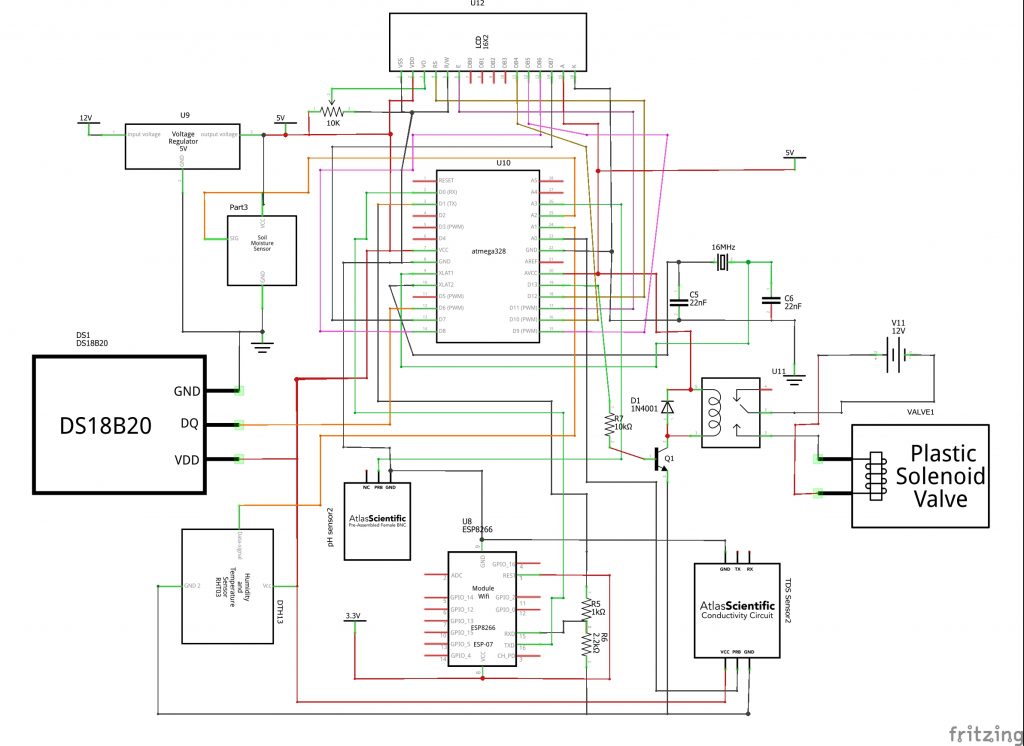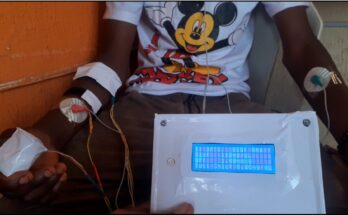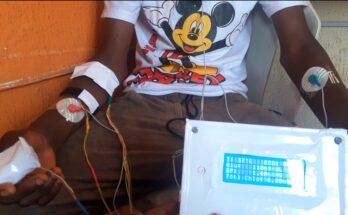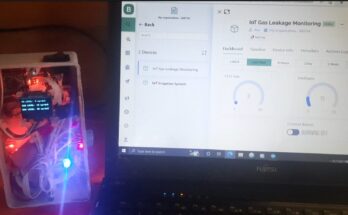This IoT based hydroponics system project design was designed to monitor and control a hydroponics farm. The scope of the project is to measure the pH, TDS value, humidity, air temperature, and water temperature of the nutrient solution. The project also automatically pumps water into the base nutrient bucket when the temperature is somewhat high or when the water level gauge says the water level is too low.
Materials for this Project:
Atmega328P-Pu microcontroller:

The Atmega328P-PU microcontroller was the type of 28-pin AVR chip used to program, sense, monitor, and control all the sensors used in the construction of this project. It is the brain of the project because it reads the analog sensors with its analog IO pins, sends serials communications and displays results also on the display modules
16MHz Crystal Oscillator:

More commonly known as simply a crystal, the crystal oscillator creates an electrical signal with a very accurate frequency. In this case, the frequency is 16 MHz Crystals are not polarized. The schematic symbol is shown in Figure 3.12. The crystal determines the microcontroller’s speed of operation. For example, the microcontroller circuit we’ll be assembling runs at 16 MHz, which means it can execute 16 million processor instructions per second. That doesn’t mean it can execute a line of sketch or a function that rapidly, however, since it takes many processor instructions to interpret a single line of code.
22pF capacitors:
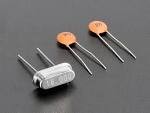
Perforated boards:
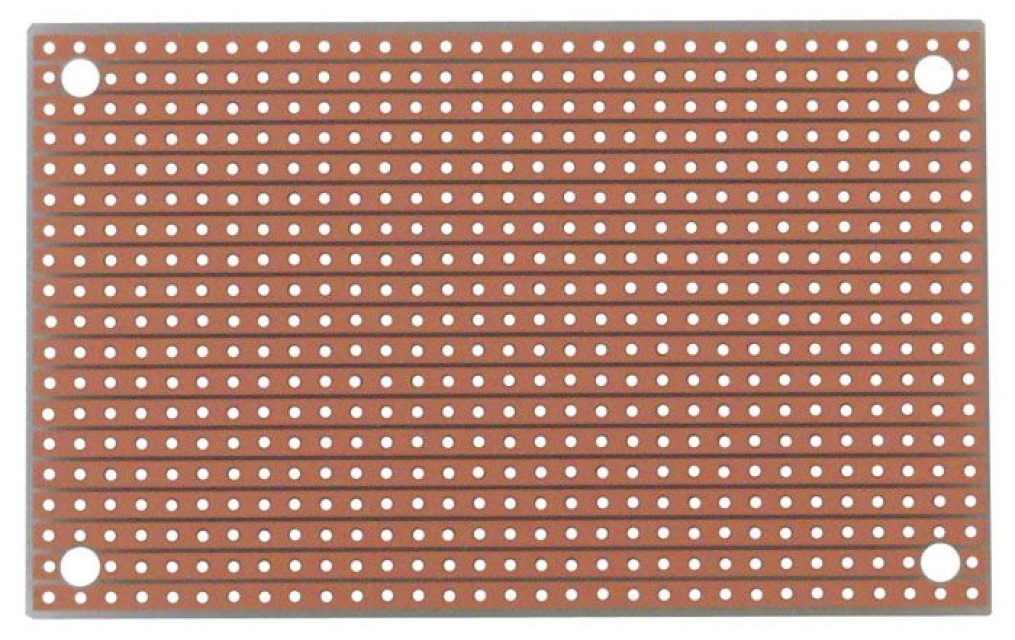
Dallas temperature sensor DS18B20:
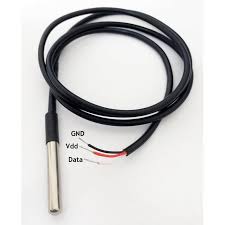
The DS18B20 digital thermometer provides 9-bit to 12-bit Celsius temperature measurements and has an alarm function with nonvolatile, user-programmable upper and lower trigger points. The DS18B20 communicates over a 1-Wire bus that, by definition, requires only one data line (and ground) for communication with a central microprocessor. In addition, the DS18B20 can derive power directly from the data line (“parasite power”), eliminating the need for an external power supply. Each DS18B20 has a unique 64-bit serial code, which allows multiple DS18B20s to function on the same 1-Wire bus. Thus, it is simple to use one microprocessor to control many DS18B20s distributed over a large area. Applications that can benefit from this feature include HVAC environmental controls, temperature monitoring systems inside buildings, equipment, or machinery, and process monitoring and control systems. We just used it to to measure temperature in this IoT Based Hydroponics System Project Design.
5V Single Channel Relay Module:
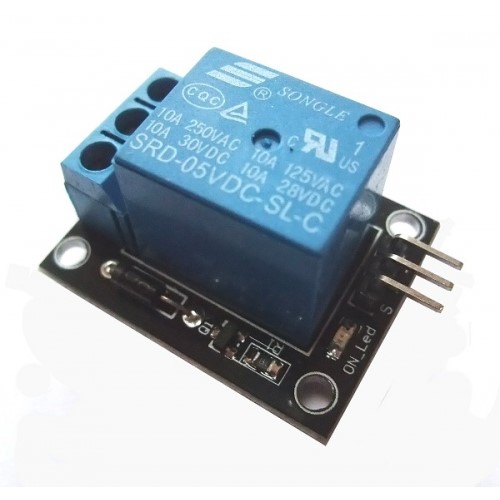
A relay is used to turn on and turn off the power supply that energizes the solenoid valve which pumps water into the hydroponic farm. Relay gets the control signal from microcontroller through a transistor( an SMD type). A diode is use in parallel with the coil pin of relay to avoid sparking in case of back EMF; because the coil is made of inductive material. The selection of the relay depended on load of our system. For example, for a maximum load of our home devices say, 10 Amperes. Another important thing considered while selecting relay for this project was switching speed of relay. The relay speed was noticed to be as fast as possible. Because the more the switching speed of relay, the more protection it will provide to the load devices when turning them on or off in minimum possible time.
pH Sensor :

Gravity Analog TDS Sensor:
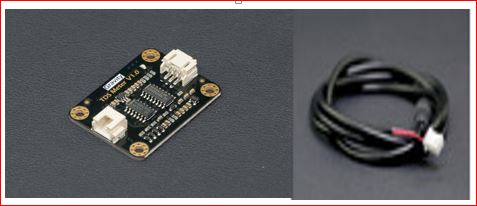
The Total Dissolved Solid sensor was used in place of the Electrical Conductivity (EC) sensor because of its relatively low cost compared to the EC sensor. Also, because there is a conversion scale between the EC sensor and the TDS sensor. This means that we could convert the reading of the TDS from its analog value to the reading in parts per million (ppm). This is an AVR microcontroller-compatible TDS sensor/Meter Kit for measuring the TDS value of the hydroponic water. It was used to reflect the cleanliness of the water; and conduct our water quality testing for the hydroponic culture. The module sensor supports 3.3–5.5V wide range voltage input and 0–2.3V analog voltage output, which makes it compatible with 5V or 3.3V control systems or development boards. The excitation source is an AC signal, which can effectively prevent the probe from polarization and prolong the lifetime of the probe. Also, increase the output signal’s stability. The TDS probe is waterproof, it can e immersed in water for a long time for measurement. However, the probe should not be used in water with temperatures above 55 °C. Again, the probe touching the container affects the reading of the TDS sensor.
20×4 Liquid Crystal Display (LCD):

An LCD is an electronic display module which uses liquid crystal to produce a visible image. The 20×4 LCD display is a very basic module commonly used in DIYs and circuits. It was used in a 4-bit configuration interfacing with the MCU. The 20×4 translates on a display 20 characters per line in 4 of such lines. In this LCD, each character is displayed in a 5×7-pixel matrix. This is the visual output where all the commands made and decisions taken by the ‘brain’, the microcontroller unit (MCU) are displayed. It has 16 special pins that are mapped out for special functions.
The ESP-01 Wi-Fi Module
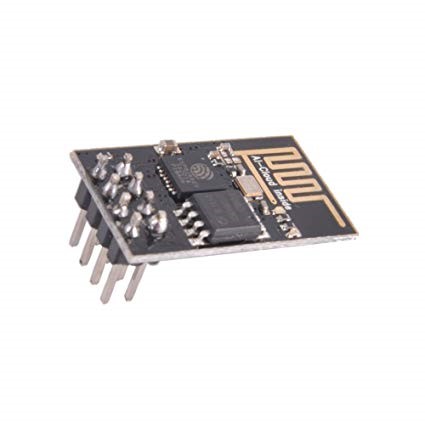
Relative Humidity and Temperature Sensor (DHT11):
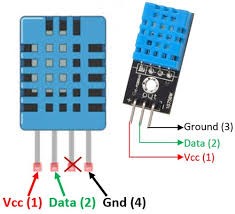
The DHT11 is a low cost digital humidity and temperature (DHT). This sensor is very basic and slow, but it is great for some basic data logging. The DHT11 sensor is made of two parts, a capacitive humidity sensor and a thermistor. There is also a very basic chip inside that does some analog-to-digital conversion and spits out a digital signal with the temperature and humidity. The digital signal is fairly easy to read using any microcontroller.
IoT Based Hydroponics System Project Design: THE CIRCUIT DIAGRAM
IoT Based Hydroponics System Project Design: Circuit Diagram Explanation
This circuit diagram was designed using Fritzing IDE. The whole circuitry was built around the Atmega328P microcontroller chip. The plastic solenoid valve was used to to irrigate the model farm; this was connected to an external 12V Dc power supply using the single channel relay. This single channel relay was controlled by the digital pin 13 of the Atmeag328P chip.
Since the power supply is already rated 12V (chosen primarily because of the solenoid valve), a voltage regulator (a better alternative is a DC-DC buck converter) was used to step down the voltage to 5V. This was connected to the microcontroller and and the rest of the sensors.
Construction of the Circuit
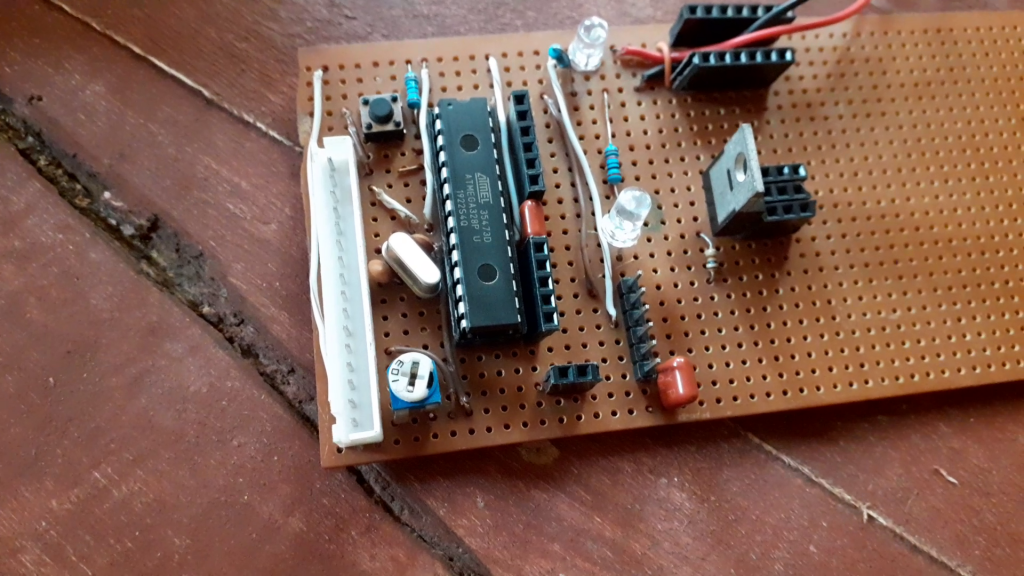
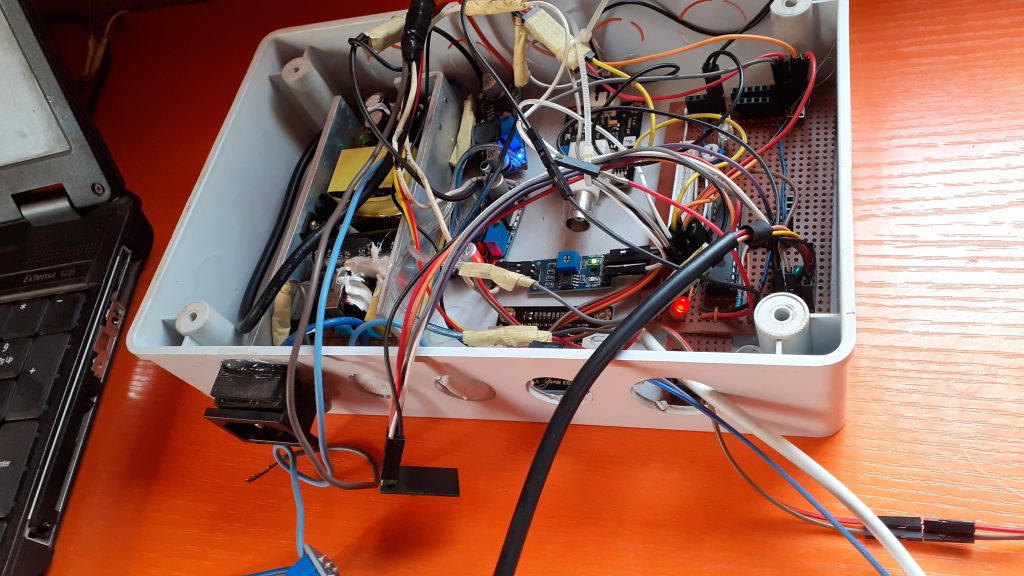
PROGRAMMING THE DESIGN.
#include <SoftwareSerial.h>
SoftwareSerial EspSerial(2, 3);
String statusChWriteKey = "xxxxxxxxxxxxxxxxx";
#define HARDWARE_RESET 4
long writeTimingSeconds = 17;
long startWriteTiming = 0;
long elapsedWriteTime = 0;
#include <DallasTemperature.h>
#include <OneWire.h>
#include "DHT.h"
// include the library code:
#include <LiquidCrystal.h>
#define ONE_WIRE_BUS 6
#define DHTPIN A0
OneWire oneWire(ONE_WIRE_BUS);
DallasTemperature sensors(&oneWire);
boolean error;
#define SensorPin A3 //pH meter Analog output to Arduino Analog Input 0
#define Offset 0.00 //deviation compensate
#define DHTTYPE DHT11 // DHT 11
#define LED 13
LiquidCrystal lcd(12, 11, 10, 9, 8, 7);
#define TdsSensorPin A1
#define VREF 5.0 // analog reference voltage(Volt) of the ADC
#define SCOUNT 30 // sum of sample point
int analogBuffer[SCOUNT]; // store the analog value in the array, read from ADC
int analogBufferTemp[SCOUNT];
int analogBufferIndex = 0,copyIndex = 0;
float averageVoltage = 0,tdsValue = 0,temperature = 25;
DHT dht(DHTPIN, DHTTYPE);
#define samplingInterval 20
#define printInterval 800
#define ArrayLenth 40 //times of collection
int pHArray[ArrayLenth]; //Store the average value of the sensor feedback
int pHArrayIndex=0;
float Celcius=0;
float Fahrenheit=0;
float h,t,f;
static float pHValue,voltage;
float newPH;
int pumpStatus;
int waterSense;
int alarmSense;
void setup(void)
{
EspSerial.begin(9600);
Serial.begin(9600);
Serial.begin(115200);
pinMode(HARDWARE_RESET, OUTPUT);
digitalWrite(HARDWARE_RESET, HIGH);
EspHardwareReset();
startWriteTiming = millis();
pinMode(LED,OUTPUT);
pinMode(TdsSensorPin,INPUT);
pinMode(A5, OUTPUT);
pinMode(A4, OUTPUT);
analogWrite(A4, 255);
analogWrite(A5, 0);
sensors.begin();
Serial.println("pH meter experiment!"); //Test the serial monitor
Serial.println(F("DHTxx test!"));
dht.begin();
//begin the lcd sensor
sensors.begin();
lcd.begin(20, 4);
lcd.setCursor(0, 0);
lcd.print(" WELCOME JALANI");
lcd.setCursor(0, 1);
lcd.print(" SMART HYDROPONIC");
lcd.setCursor(0, 2);
lcd.print(" INTERNET OF THINGS");
lcd.setCursor(0, 3);
lcd.print(" PROJECT");
delay(3000);
lcd.clear();
lcd.setCursor(0, 0);
lcd.print(" PLS ");
lcd.setCursor(0, 1);
lcd.print(" GIVE TIME ");
lcd.setCursor(0, 2);
lcd.print(" FOR THE SENSORS ");
lcd.setCursor(0, 3);
lcd.print(" TO BOOTH ");
delay(2000);
lcd.clear();
lcd.setCursor(1, 0);
lcd.print("TEMP");
lcd.setCursor(9, 0);
lcd.print("TDS");
lcd.setCursor(18, 0);
lcd.print("pH");
lcd.setCursor(0, 2);
lcd.print("W.LEVEL");
lcd.setCursor(9, 2);
lcd.print("HUM");
lcd.setCursor(14, 2);
lcd.print("A.TEMP");
}
void waterLevel(){
waterSense= analogRead(A2);
Serial.println(waterSense);
//print out on LCD
lcd.setCursor(0, 3);
lcd.print(waterSense);
//lcd.setCursor(3, 3);
//lcd.print("cm");
delay(500);
if(waterSense > 500){
analogWrite(A4, 0);
}
if(waterSense <= 240){
analogWrite(A4, 255);
}
}
void humSensor(){
// Wait a few seconds between measurements.
delay(2000);
// Reading temperature or humidity takes about 250 milliseconds!
// Sensor readings may also be up to 2 seconds 'old' (its a very slow sensor)
h = dht.readHumidity();
// Read temperature as Celsius (the default)
t = dht.readTemperature();
// Read temperature as Fahrenheit (isFahrenheit = true)
f = dht.readTemperature(true);
// Check if any reads failed and exit early (to try again).
if (isnan(h) || isnan(t) || isnan(f)) {
Serial.println(F("Failed to read from DHT sensor!"));
return;
}
// Compute heat index in Fahrenheit (the default)
float hif = dht.computeHeatIndex(f, h);
// Compute heat index in Celsius (isFahreheit = false)
float hic = dht.computeHeatIndex(t, h, false);
lcd.setCursor(8, 3);
lcd.print(h);
lcd.setCursor(15, 3);
lcd.print(t);
if(h <= 10.00){
analogWrite(A5, 255);
lcd.clear();
lcd.setCursor(0, 0);
lcd.print("AIR TOO DRY");
}
else {
}
Serial.print(F("Humidity: "));
Serial.print(h);
Serial.print(F("% Temperature: "));
Serial.print(t);
Serial.print(F("°C "));
Serial.print(f);
Serial.print(F("°F Heat index: "));
Serial.print(hic);
Serial.print(F("°C "));
Serial.print(hif);
Serial.println(F("°F"));
}
void pH(){
static unsigned long samplingTime = millis();
static unsigned long printTime = millis();
if(millis()-samplingTime > samplingInterval)
{
pHArray[pHArrayIndex++]=analogRead(SensorPin);
if(pHArrayIndex==ArrayLenth)pHArrayIndex=0;
voltage = avergearray(pHArray, ArrayLenth)*5.0/1024;
pHValue = 3.5*voltage+Offset;
samplingTime=millis();
}
if(millis() - printTime > printInterval) //Every 800 milliseconds, print a numerical, convert the state of the LED indicator
{
Serial.print("Voltage:");
Serial.print(voltage,2);
newPH = pHValue + 5.60;
newPH = map(newPH, 0.00, 14.00, 1.00, 14.00);
Serial.print(" pH value: ");
Serial.println(newPH,2);
lcd.setCursor(17, 1);
lcd.print(newPH);
digitalWrite(LED,digitalRead(LED)^1);
printTime=millis();
}
}
double avergearray(int* arr, int number){
int i;
int max,min;
double avg;
long amount=0;
if(number<=0){
Serial.println("Error number for the array to avraging!/n");
return 0;
}
if(number<5){ //less than 5, calculated directly statistics
for(i=0;i<number;i++){
amount+=arr[i];
}
avg = amount/number;
return avg;
}else{
if(arr[0]<arr[1]){
min = arr[0];max=arr[1];
}
else{
min=arr[1];max=arr[0];
}
for(i=2;i<number;i++){
if(arr[i]<min){
amount+=min; //arr<min
min=arr[i];
}else {
if(arr[i]>max){
amount+=max; //arr>max
max=arr[i];
}else{
amount+=arr[i]; //min<=arr<=max
}
}//if
}//for
avg = (double)amount/(number-2);
}//if
return avg;
}
void TDS(){
static unsigned long analogSampleTimepoint = millis();
if(millis()-analogSampleTimepoint > 40U) //every 40 milliseconds,read the analog value from the ADC
{
analogSampleTimepoint = millis();
analogBuffer[analogBufferIndex] = analogRead(TdsSensorPin); //read the analog value and store into the buffer
analogBufferIndex++;
if(analogBufferIndex == SCOUNT)
analogBufferIndex = 0;
}
static unsigned long printTimepoint = millis();
if(millis()-printTimepoint > 800U)
{
printTimepoint = millis();
for(copyIndex=0;copyIndex<SCOUNT;copyIndex++)
analogBufferTemp[copyIndex]= analogBuffer[copyIndex];
averageVoltage = getMedianNum(analogBufferTemp,SCOUNT) * (float)VREF / 1024.0; // read the analog value more stable by the median filtering algorithm, and convert to voltage value
float compensationCoefficient=1.0+0.02*(temperature-25.0); //temperature compensation formula: fFinalResult(25^C) = fFinalResult(current)/(1.0+0.02*(fTP-25.0));
float compensationVolatge=averageVoltage/compensationCoefficient; //temperature compensation
tdsValue=(133.42*compensationVolatge*compensationVolatge*compensationVolatge - 255.86*compensationVolatge*compensationVolatge + 857.39*compensationVolatge)*0.5; //convert voltage value to tds value
//Serial.print("voltage:");
//Serial.print(averageVoltage,2);
//Serial.print("V ");
Serial.print("TDS Value:");
Serial.print(tdsValue,0);
Serial.println("ppm");
lcd.setCursor(8, 1);
lcd.print(tdsValue);
lcd.setCursor(13, 1);
lcd.print("ppm");
}
}
int getMedianNum(int bArray[], int iFilterLen)
{
int bTab[iFilterLen];
for (byte i = 0; i<iFilterLen; i++)
bTab[i] = bArray[i];
int i, j, bTemp;
for (j = 0; j < iFilterLen - 1; j++)
{
for (i = 0; i < iFilterLen - j - 1; i++)
{
if (bTab[i] > bTab[i + 1])
{
bTemp = bTab[i];
bTab[i] = bTab[i + 1];
bTab[i + 1] = bTemp;
}
}
}
if ((iFilterLen & 1) > 0)
bTemp = bTab[(iFilterLen - 1) / 2];
else
bTemp = (bTab[iFilterLen / 2] + bTab[iFilterLen / 2 - 1]) / 2;
return bTemp;
}
void loop(void)
{
sensors.requestTemperatures();
Celcius=sensors.getTempCByIndex(0);
Fahrenheit=sensors.toFahrenheit(Celcius);
Serial.print(Celcius);
Serial.print(" 'C ");
if(Celcius >= 85.00){
analogWrite(alarmSense, 255);
lcd.clear();
lcd.setCursor(0, 0);
lcd.print("TEMP TO HIGH!");
}
else{
}
lcd.setCursor(0, 1);
lcd.print(Celcius);
lcd.setCursor(5, 1);
lcd.print("'C");
Serial.println(Celcius);
delay(500);
waterLevel();
pH();
humSensor();
TDS();
int pumpStatus = analogRead(A4);
int alarmSense = analogRead(A5);
//start: //label
//error=0;
elapsedWriteTime = millis()-startWriteTiming;
if (elapsedWriteTime > (writeTimingSeconds*1000))
{
writeThingSpeak();
startWriteTiming = millis();
}
if (error==1) //Resend if transmission is not completed
{
Serial.println(" <<<< ERROR >>>>");
delay (2000);
//goto start; //go to label "start"
}
}
void writeThingSpeak(void)
{
startThingSpeakCmd();
// preparacao da string GET
String getStr = "GET /update?api_key=";
getStr += statusChWriteKey;
getStr +="&field1=";
getStr += String(t);
getStr +="&field2=";
getStr += String(h);
getStr +="&field3=";
getStr += String(Celcius);
getStr +="&field4=";
getStr += String(newPH);
getStr +="&field5=";
getStr += String(tdsValue);
getStr +="&field6=";
getStr += String(waterSense);
getStr +="&field7=";
//getStr += String(pumpStatus);
getStr +="&field8=";
//getStr += String(alarmSense);
getStr += "rnrn";
sendThingSpeakGetCmd(getStr);
}
void EspHardwareReset(void)
{
Serial.println("Reseting.......");
digitalWrite(HARDWARE_RESET, LOW);
delay(500);
digitalWrite(HARDWARE_RESET, HIGH);
delay(8000);//Tempo necessário para começar a ler
Serial.println("RESET");
}
/********* Start communication with ThingSpeak*************/
void startThingSpeakCmd(void)
{
EspSerial.flush();//limpa o buffer antes de começar a gravar
String cmd = "AT+CIPSTART="TCP","";
cmd += "184.106.153.149"; // Endereco IP de api.thingspeak.com
cmd += "",80";
EspSerial.println(cmd);
Serial.print("enviado ==> Start cmd: ");
Serial.println(cmd);
if(EspSerial.find("Error"))
{
Serial.println("AT+CIPSTART error");
return;
}
}
/********* send a GET cmd to ThingSpeak *************/
String sendThingSpeakGetCmd(String getStr)
{
String cmd = "AT+CIPSEND=";
cmd += String(getStr.length());
EspSerial.println(cmd);
Serial.print("enviado ==> lenght cmd: ");
Serial.println(cmd);
if(EspSerial.find((char *)">"))
{
EspSerial.print(getStr);
Serial.print("enviado ==> getStr: ");
Serial.println(getStr);
delay(500);//tempo para processar o GET, sem este delay apresenta busy no próximo comando
String messageBody = "";
while (EspSerial.available())
{
String line = EspSerial.readStringUntil('n');
if (line.length() == 1)
{ //actual content starts after empty line (that has length 1)
messageBody = EspSerial.readStringUntil('n');
}
}
Serial.print("MessageBody received: ");
Serial.println(messageBody);
return messageBody;
}
else
{
EspSerial.println("AT+CIPCLOSE"); // alert user
Serial.println("ESP8266 CIPSEND ERROR: RESENDING"); //Resend...
//spare = spare + 1;
error=1;
return "error";
}
}
The above sketch is to be uploaded into the standalone board using the Arduino IDE and then the next is to configure Thingspeak DB and create an app using MIT AppInventor.
Configuring Thingspeak IoT DashBoard
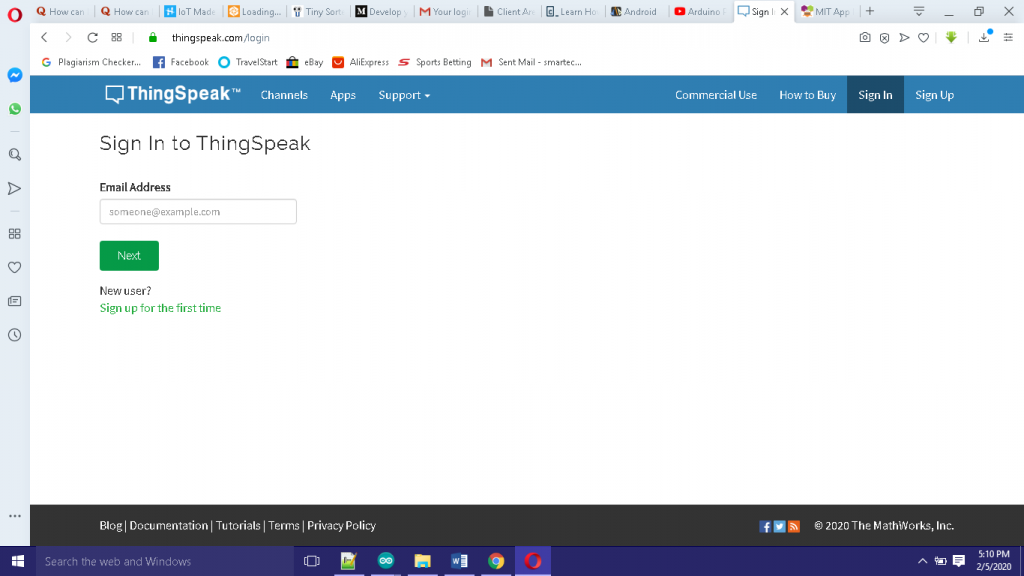
To use thingspeak database, we need to create a Matlab account. Simply sign up on their website; After signing up, verify your email and sign in.
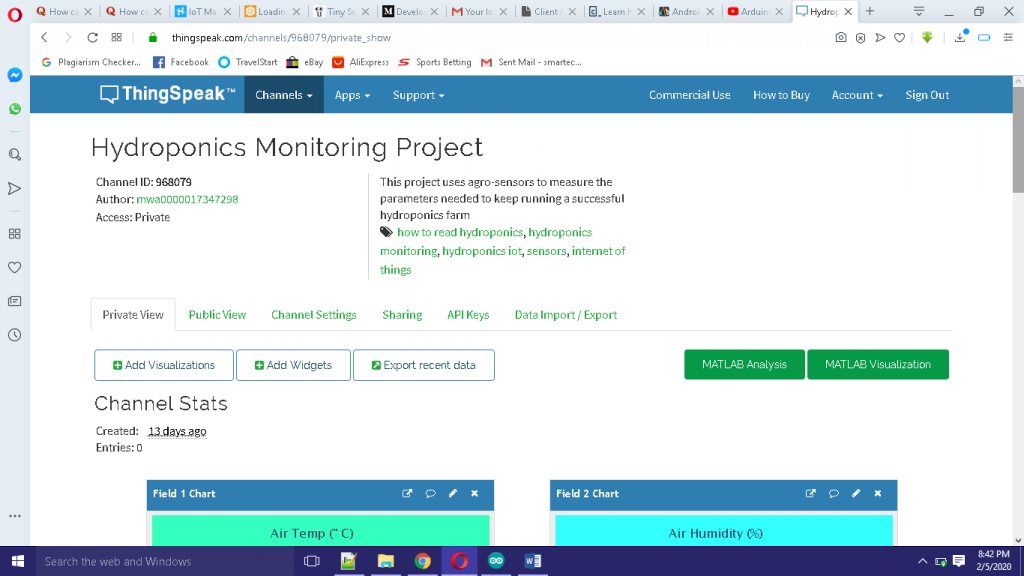
Once signed in, create a channel. Name your channel. Copy and safely store the API Write Key and the API Read Key. You can allocate your channel to any number of fields or charts. For us, we used 8 fields: 6 for sensors and 2 for actuators.
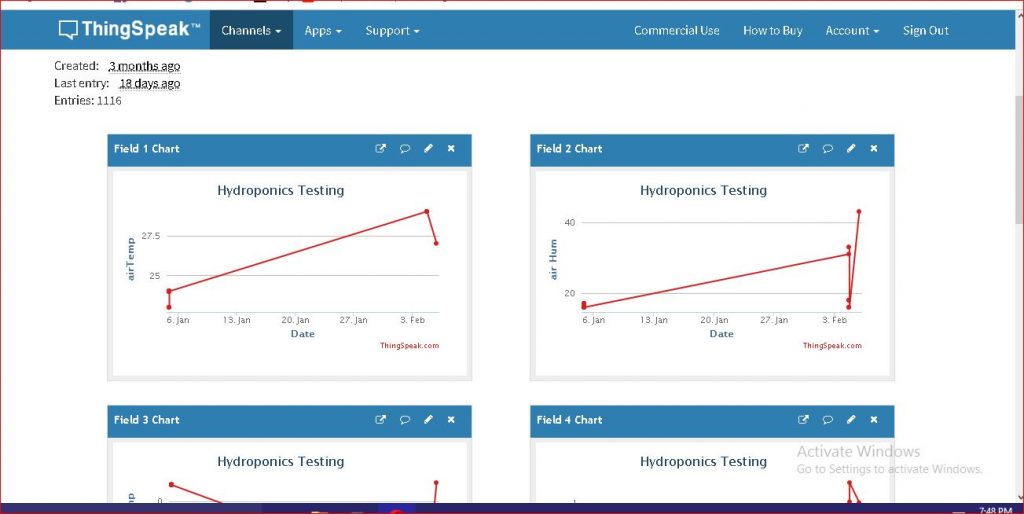
After changing the API Write Key in your sketch, upload the code to see this working on the thingspeak channel you made.
MIT AppInventor
Next go to MIT app inventor website to create your app. After signing in, you can just import our already made .aia file into your project. You can edit any part of it to your taste. Just make sure to change the API write key to your own.
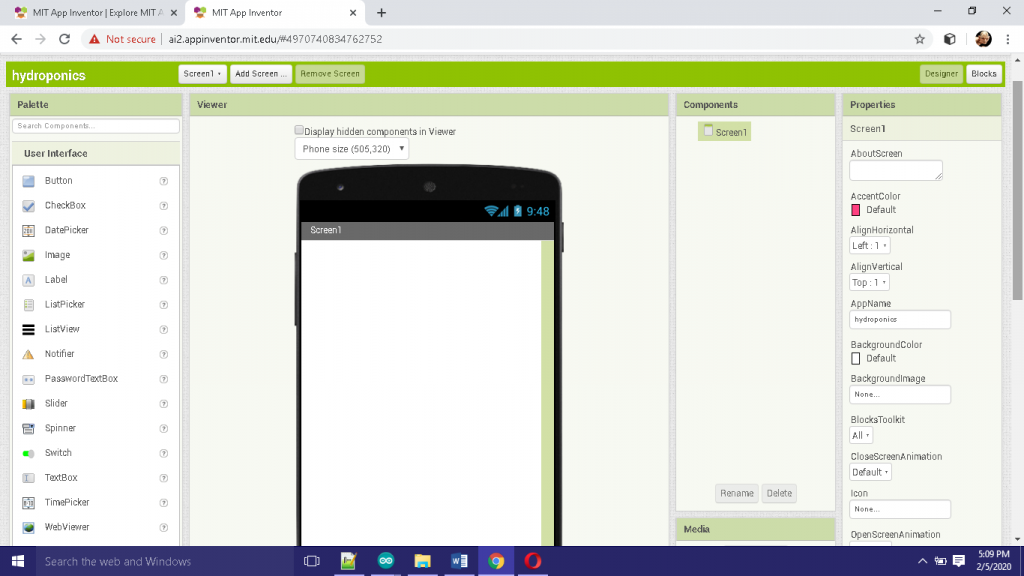
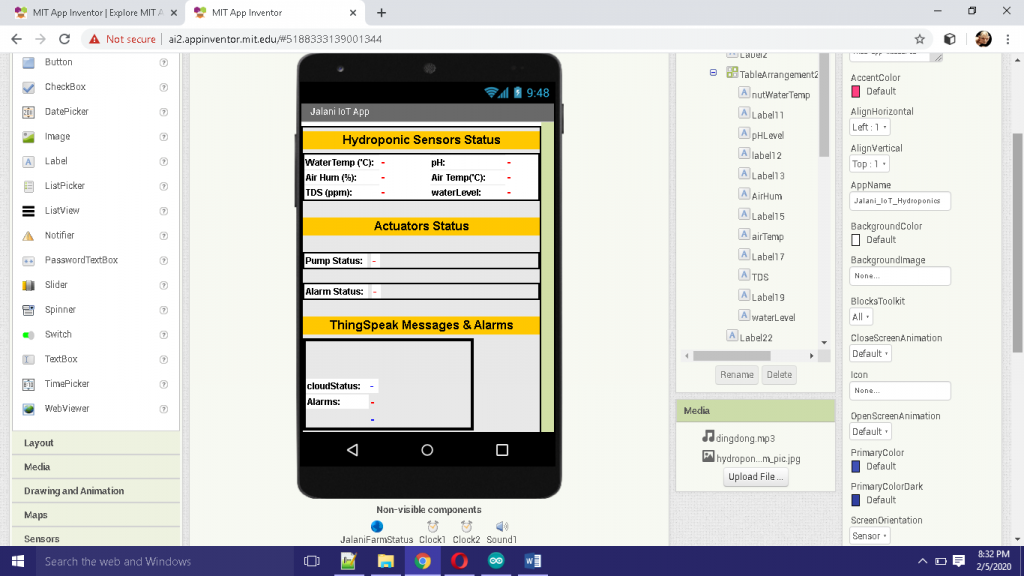
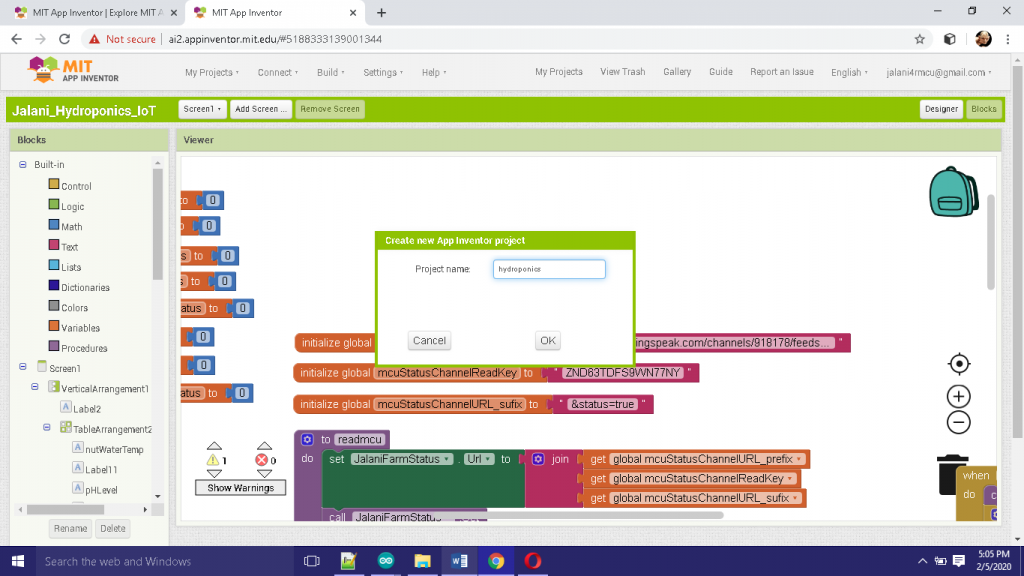
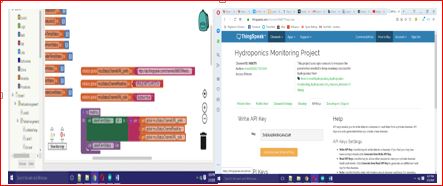
Once the app is done, you could either use the emulator to test it or build it and copy it to your Android phone for installation. After running the app, you can compare the reading with those updates on Thingspeak DB.
Now the sensor and actuator states can be viewed anywhere around the globe using a web app or a mobile app.
But also the actuators, the solenoid pump is meant to automatically pump water into the base bucket when the water level is too low, and the alarm is meant to go off when the temperature is too high. The threshold for this state can be adjusted in the sketch above.
A visual tutorial is given in the YouTube video below.
I hope this project tutorial helps you.
